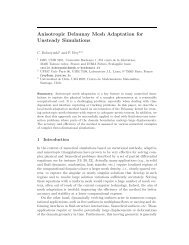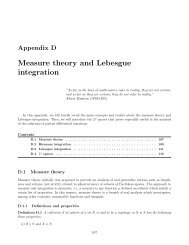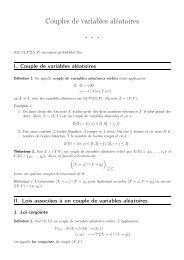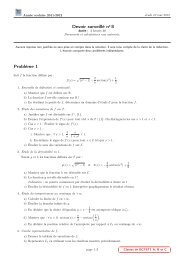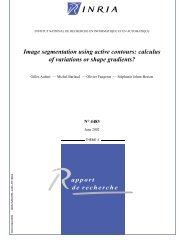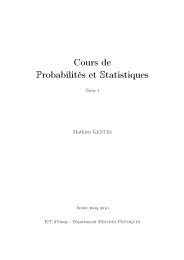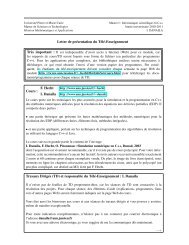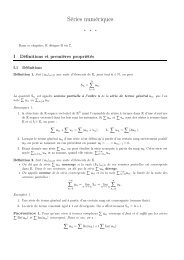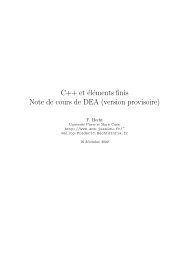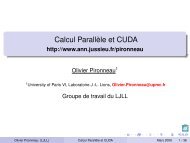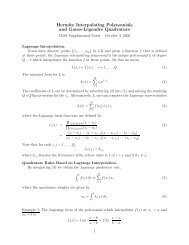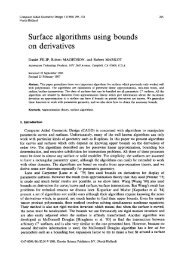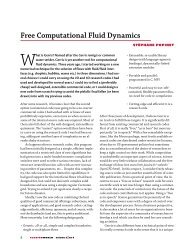pdf file
pdf file
pdf file
You also want an ePaper? Increase the reach of your titles
YUMPU automatically turns print PDFs into web optimized ePapers that Google loves.
44 M. LEWIN, P. T. NAM, S. SERFATY, AND J. P. SOLOVEJ<br />
detailed proof) that the Bogoliubov transformation V := SV0S diagonalizes<br />
A, namely<br />
VAV ∗ �<br />
ξ 0<br />
=<br />
0 JξJ∗ �<br />
(71)<br />
for some operator ξ on H. From (66) and (71), we deduce that ξ ≥ η > 0.<br />
Using the Bogoliubov transformation V, we can find a unitary transformation<br />
UV on the Fock space F(H), called the Bogoliubov unitary (see e.g.<br />
[56, 44]), such that<br />
UVHU ∗ V −infσ(H) = dΓ(ξ) :=<br />
∞�<br />
N�<br />
ξi.<br />
N=0 i=1<br />
This implies that H has a unique ground state and σ(H) = infσ(H)+dΓ(ξ).<br />
5. Next, from (71) and the assumption VSV∗ = S, it follows that<br />
�<br />
ξ 0<br />
S<br />
0 JξJ∗ �<br />
−λ = SVAV ∗ −λ = SVS(SA−λ)V ∗ .<br />
Thus σ(ξ) = σ(SA) because V is an isomorphism on H⊕H∗ . Consequently,<br />
��<br />
σ(H) = infσ(H)+ niλi | λi ∈ σ(SA),{ni} ⊂ N and � �<br />
ni < ∞ .<br />
i≥1<br />
6. Now we prove that σess(ξ) = σess(H). From (71), it follows that<br />
σ(ξ) = σ(VAV ∗ ). On the other hand, since K is a compact operator on H,<br />
one has σess(A) = σess(H). On the other hand, by using the identity<br />
VAV ∗ −λ = V(A−λ)V ∗ +λ(VV ∗ −1)<br />
and the fact that (VV ∗ −1) is compact (indeed it is trace class), we obtain<br />
σess(VAV ∗ ) = σess(A). Thus σess(ξ) = σess(H). Consequently, from σ(H) =<br />
infσ(H)+σ(dΓ(ξ)) we obtain<br />
σess(H) = infσ(H)+σess(dΓ(ξ)) = σ(H)+σess(H).<br />
7. From now on, we assume that JKJ = K and JHJ ∗ = H. In this<br />
case, (66) implies that H +K ≥ η > 0 and H −K ≥ η > 0. Before going<br />
further, let us give a simple characterization of the spectrum of H. We only<br />
deal with eigenvalues for simplicity.<br />
Assume that t > 0 is an eigenvalue of ξ. Then from the above proof, we<br />
see that t is an eigenvalue of SA. Using the equation<br />
� � �<br />
u H K<br />
0 = (SA−t) =<br />
v −K −JHJ ∗<br />
�� � � �<br />
u u<br />
−λ<br />
v v<br />
we find that � (H +K)x = ty,<br />
(H −K)y = tx,<br />
where x = u+v and y = u−v. Thus<br />
�<br />
H +K − t2<br />
�<br />
x = 0.<br />
H −K



